Leeds East Moor Reformatory for Boys, Adel, near Leeds, West Riding of Yorkshire
In January 1857, a meeting in Leeds, under the chairmanship of the mayor, resolved that a boys' reformatory school should be established for convicted juveniles. The institution was to be run by a voluntary body, the Leeds Society for the Reformation of Juvenile Offenders (LSRJO), a committee of public spirited citizens.
The institution was to be erected on twenty-acre site three miles north of Leeds at the eastern part of Adel Moor, leased from Edwin Eddison's estate for 20 years at 12s per acre. Sufficient money had already been subscribed to erect the necessary buildings "according to a model prepared by Mr Hewitson". Running costs were met from subscribers and from government grants from the Treasury. The reformatory's first buildings were erected during 1857 and certified on 2nd December 1857 for the accommodation of up to 60 boys.
In 1859, forty-two boys were in residence. They were put to work in extending the school buildings and added a shoemaker's shop, joiner's shop, and smith's shop and gas-house, a cow-house for six cows, pigsties for six pigs, a stable, and a large shed for carts. The stone for all these structures and for 400 yards of fence wall had been obtained from the institution's own land. In addition, two acres of land were drained and three acres broken up and prepared for crops including oats, potatoes, turnips and garden produce. Barren moorland was enclosed and made fertile and trees were planted. In the process of cultivating the land, many stone-age flint arrow heads were uncovered.
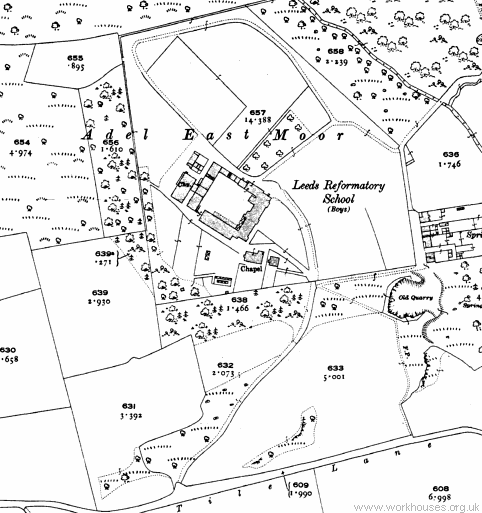
Leeds Boys Reformatory site, 1921.

Leeds Boys' reformatory main building from the east, 2008. © Peter Higginbotham
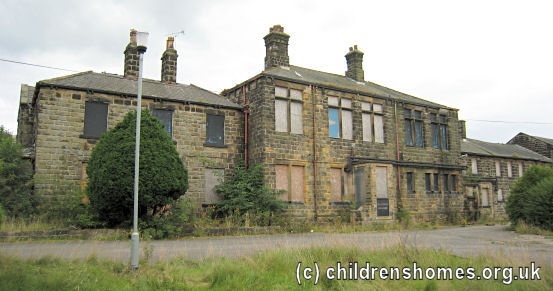
Leeds Boys' reformatory main building from the north-east, 2008. © Peter Higginbotham
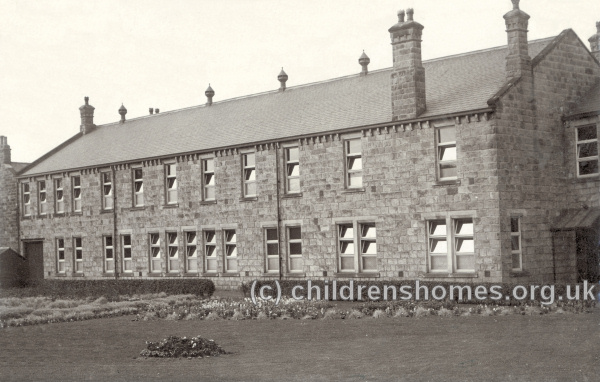
Leeds Boys' reformatory main building from the south-east, c.1908. © Peter Higginbotham
The school's first superintendent was Joshua Haresceugh. Mrs Haresceugh acted as the school's matron and their son was the assistant superintendent. The Haresceughs, plus one farm labourer, were at that time the only staff employed by the school. After the departure of the Haresceughs in 1864, a series of temporary and unsuitable superintendents ended with the appointment in 1866 of Charles Godfrey Twigg who became a popular and much respected holder of the post.
Despite its out-of-town location, the reformatory cultivated a variety links with the city. In February 1859, some of the boys attended a service at Headingley church and between themselves made a collection of 2s. 11½d. to add to the church collection. The school had its own band and team of handbell ringers who gave concerts and performed at local events.
The work performed by the inmates could sometimes be used to generate income for the Reformatory. In 1866, the September a six-acre crop of potatoes was advertised for sale. Two years later, bundles of firewood were being offered at 3s. per hundred, with orders of 500 or more delivered free within a five-mile radius.
In 1875, with the original lease about to expire, the LSRJO purchased the site outright but persuaded the Leeds Corporation to buy it from then and then lease it back at a nominal figure. In 1878, the accommodation was enlarged to accommodate up to 150 boys.
At around 8pm on the night of Saturday November 27th, 1880, a fire broke out in the workshop block at the west side of the main quadrangle. Although the Reformatory had its own fire engine on site, low water pressure made it ineffective and a messenger was despatched to the Headingley police station to summon the Corporation fire brigade who received the alarm at 8.40pm. They set out with their horse-drawn steam-engine which took more than an hour to reach the school. Water had then to be raised from a stream about 500 yards away. Although the workshop block was gutted, none of the residents was harmed.
The workshops were rebuilt in 1881. The new design, by a Mr Moseley, included an exterior stone staircase. A new building for use as a chapel and assembly room was erected at the south of the main building in 1882. A swimming pool had been installed by 1888.
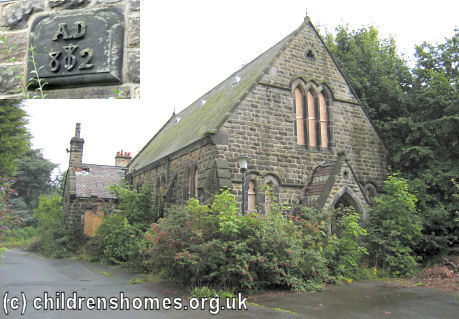
Leeds Boys' Reformatory chapel and assembly room, 2008. © Peter Higginbotham
On 1st Dec 1888, the Leeds Mercury carried a report on the school from their "special correspondent", extracts of which are included below.
One hundred and fifty boys are now under instruction, and during the term in which Mr. Twigg has held office upwards of one thousand boys have passed through the school, and have gone out into the world fairly equipped for the battle of life. An album, in which the superintendent takes much pride, contains many photographs of lads whose training at the Adel School enabled them to reach a social level which would have been extremely difficult, if not impossible, of attainment without the moral and intellectual aid afforded them during their enforced sojurn at Adel. Here, for example, was the portrait of a warrant-officer in the army. This officer had been sent to the Reformatory on account of a by no means serious larceny. He was rescued from the demoralising custody of dissolute parents, and being placed in the band speedily exhibited that passion for music and close application to the study of its principles which has led to his occupying the honourable position of bandmaster in Her Majesty's service. The portrait of a sergeant in a line regiment is also here, Whilst still very young he had three convictions recorded against him before he reached the Reformatory. His conduct was in all respects satisfactory, and after he joined the army only one year elapsed before he attained the rank of non-commissioned officer. Scattered through this interesting album are the portraits of not a few old scholars who fell at Abu Klea and on other battlefields of the burning Soudan. Others are here depicted wearing the garb of fishermen or of seamen. Numbers of the boys have gone to Grimsby on their release, and have, under the vigilant supervision of a paid agent, engaged to serve aboard fishing smacks on the Dogger Bank The calling seems to suit the lads, for many of them — grown in a few short months into broad-shouldered toilers of the deep — have revisited the school and expressed to the superintendent their satisfaction with the arduous and honourable calling which they had adopted. One lad communicated to Mr. Twigg the singular fact that he had served on board a North Sea fishing-smack, the entire crew of which, from the skipper to the cook, had been trained in the Reformatory at Adel. Passing through the dining-room, from the walls of which the fierce lion, the stealthy panther, and other notable animals in mezzo-tint or chrome, looked down upon the boys at meal times, I was shown into the office where the register is kept. In the register is recorded the name, ago, height, &c., of each boy committed to the school. A record of previous convictions is also kept, and it struck me, on looking through that record, that a very large percentage of the boys had come under the ban of the law before the commission of the specific offence which led to their being sent to Adel. I found on consulting the Superintendent that my observation was correct. It is most usual to find that a boy has been convicted over and over again before blindfold Justice gropes her way to a sentence which will give the youthful depredator a chance of mending his ways. On one page of the register I found the subjoined record of previous charge against a boy recently admitted to the Reformatory. (1) Stealing cigars — discharged. (2) Stealing sweets — discharged. (3) Stealing can of condensed milk — birched. (4) Attempt to steal — birched, (5) Stealing silk handkerchief — discharged. (6) Attempt to steal money from a till — twenty-one days' imprisonment, to be followed by five years in Reformatory. This ingenious young person had been treated with considerable leniency in the early stages of his enterprising career, and he showed his appreciation of magisterial mercy by operating upon other people's goods at the earliest possible moment. Mr. Twigg, speaking with the authority which comes of the experience of more than quarter of a century's reformatory work, is of opinion that the discharge of a juvenile offender on his first conviction is a wise and judicious method of procedure; but he contends that only mischief results from treating boys in the manner indicated by the foregoing record. When a boy exhibits unmistakable signs of a bias towards theft he should be removed from the scene of temptation. But this removal, in Mr. Twigg's opinion, should not include a term of imprisonment in a common gaol. There does not appear to be any reason founded on experience which makes the committal of a boy to gaol a necessary preliminary to his detention in a Reformatory. The tendency of that imprisonment is to harden the boy; to transform a child of weak moral fibre into a callous criminal, and too often to brand with the stamp of a gaol-bird a boy whose sin against society could be adequately punished without resort to methods employed against hardened offenders.
The influence of the school does not close when the boy is discharged, for in addition to the valuable technical education and moral instruction imparted to the lads during their stay in the institution, inquiries are made annually for a period of three years concerning the conduct of discharged lads, and a report is forwarded to the Home Office. The duty of making inquiries is easily enough performed when the precise address of a discharged boy is known. He can be communicated with and asked to furnish the name of his employer or other responsible person, who will report upon his conduct and prospects. But when the town in which the boy is residing is only known the duty of making the requisite inquiries is transferred to the police. Mr. Twigg is emphatic in declaring that 'this duty is generally performed in such a way as to inflict no injury upon the social prospects or the feelings of the lad. But there have occurred a few cases in which the duty has been, performed in such a blundering, thoughtless fashion as to expose the lad to disgrace and humiliation. A short time ago the Superintendent had occasion to make the inquiry respecting a boy in a Staffordshire town. The boy's exact address was not known, and the police authorities of the town were asked, to discover the lad's whereabouts and report. They-performed their task in a manner which showed a deplorable lack of discretion. Two constables in uniform entered the blacksmith's shop whore the lad was at work, and in the presence of his master and fellow-workmen told him that "Mr. Twigg, of the Adel Reformatory," wished to know how he was getting on. The lad subsequently wrote to Mr. Twigg, bitterly complaining of the conduct of the police in the matter. Mr. Twigg had replied, as a matter of course, on the discreet action of the police, but he was disappointed.
In the dormitories the. beds are arranged in rows, the rooms are as clean as energetic scrubbing can make them, and on the walls are placed simple, pretty pictures, which impart a, cheerful air to the dormitory, and relieve the monotony of a whitewashed wall. As we descended the broad staircase from the dormitories, I heard the musical tinkling of bells, and entering the school-room, found half a dozen boys under the tuition of a master, extracting sweet sounds from hand-bells. The performers were fully alive to the gravity of the occasion. The little fellow who was responsible for the treble part worked away in the most untiring manner, now with his right hand, then with his left, then with both hands together, never once relaxing his study of the score which lay on the table before him. The alto and tenor performers had occasionally a few bars' rest, which was not, much of a rest after all, for they went on counting "one, two, three, four" in muffled monotone whilst the bass singers chimed in with profound sonorosity. These campanologists were terribly in earnest, and if each one of them had not a furious headache their escape from that infliction was by no means due to lack of energy. Crossing the recreation yard and covered play-ground we entered the "Chip-shop," where about a score of boys were engaged in preparing firewood for sale. A. big boy at a circular saw reduced the large pieces of timber to manageable sections, other boys sliced the blocks into-splinters, and the smallest boys with a rope and lever made the chips into bundles in readiness for transport. In the boiler-shed were seen the boiler and engine which drive the circular saw, and which will eventually drive the lathes which are to be placed in the joiner's shop. In charge of the engine — which was splendidly kept, and ran with the accuracy of an eight-day clock — we found a lad who left the school several months ago, and who, finding himself out of employment a few weeks ago, returned to the school and sought shelter until some employment offered for him. This willingness to temporarily lodge boys who have been discharged is not the least noticeable feature of the beneficent management. Lack of employment and the straitened means which follow enforced idleness might easily lead a boy bath into the bad old way, from which danger he is saved by taking refuge, for the time being, at the school. In the joiner's shop, eight boys under the superintendence of a work-master were engaged with chisel, saw, or plane in the making of plain deal furniture and the dexterity with which the boys did their work was a practical lesson on the value of an education which is not confined to the "three R's," but which takes into account the need for educating the hand and eye in co-ordination with the reflective faculties. In the tailor's shop, twelve boys, as sedate as pashas from far Stamboul, wore stitching away at a great rate. The tailor boys, under the eye of a master, make the clothing which is worn by the inmates, and I was shown a material for the boys' Sunday dress which would have delighted by its velvety sheen and textile strength a Flemish burgomaster of the seventeenth century. In the shoemakers' shop the sons of Crispin hammered and stitched with unexampled industry, till at the blast of a fog-horn, or some such musical instrument, boots, shoes, hammers, and awl were thrown down, and the shoemakers rushed pell-mell downstairs to man the fire engine. The foghorn blast was the signal for "fire-drill." With a rush the boys dragged the manual engine out of the shed, and trundled it off to the spacious swimming-bath. Lengths of hose were quickly stretched along and coupled, and in less than three minutes from the sounding of the fire-signal the pumps were clanging beneath the sturdy pull of the lads, and a jet of water was mounting high in the air. This sort of exercise is invaluable, not only as a precautionary measure, but as a disciplinary lesson to the lads. A brief visit to the greenhouses and a cursory glance at the wide tract of land which has been brought under cultivation by the boys, and where they acquire such knowledge of husbandry as fits them for farm work after their probation is over, brought us up to school-time. But before I visited the classes under instruction, I heard the well-trained band perform a selection from "Masaniello." I have heard that particular excerpt performed by a goodly number of bands at one time and another, and I have heard it rendered by grown-up musicians in a manner which would give no cause for envy to the band-boys of the Reformatory at Adel.
In the first schoolroom the boys of Standard VI. were seated at long tables in the mellow light of oil-lamps, elucidating the mysteries of "2¼ X 5.4." Standard IV. were writing in their copy-books; most of the boys being capable of calligraphy which excited my envy, and which would have brought sunshine into the lives of the hapless compositors who are doomed, for their sins, to translate the appalling hieroglyphics inflicted upon them by the present writer. At my request Mr. Black, the senior assistant schoolmaster, set this practical sum for the consideration of Standard Vl.:- "The rent of 42 acres of land is £63; how many acres of land of the same quality can be rented for £273?" I essayed that problem, and had the satisfaction of seeing an arch-looking youngster turn his slate over and fold his arms just two minutes and a half before I finished the working and discovered that I was wrong to the extent of six acres. I fear that land-buying is not exactly in my line. In the schoolroom over which Mr. Walker, the head master, presided, Standards V., III., and the junior classes — under Mr. Hustler — were being instructed. The work done by the boys in this department was remarkable for its neatness, and in both departments the discipline of the boys reflects credit upon the teachers.
At the close of the school hours the boys were marched to the lecture hall, where, to the accompaniment of a small organ, they sang several hymns with considerable vigour and expression. Soon after I took my leave of the superintendent, Who is, in my judgment, a man fitted by gifts and attainments for the responsible position he holds. Avoiding the low road, where danger lurked from rugged ground and darkness, I struck across the moor by the highway, leaving behind me the twinkling lights in the school, where so many boys have been guided to the path of duty and shielded from imminent danger of social and moral destruction.
On Saturday January 6th, 1894, during a period of severe frost, two 15-year-old boys boys named William Paley and Frederick Smith were killed while attending to the boiler used to heat the school chapel. The pipes which connected to the boiler had become frozen and the steam being generated could not escape. The build-up of pressure caused the boiler to explode fifteen minutes later. Paley died instantly, while Smith was treated by PC Clarkson who applied oil to the boy's wounds then swathed him in oil-soaked cotton wool before accompanying him to Leeds Infirmary. The unfortunate Smith, suffering much pain, died the following day.
The internal courtyard was paved over in 1889 and the following year, alterations to existing buildings provided storerooms, kitchens, bakehouse, officer's rooms and sink room. The swimming pool was covered in 1897 and electric light was installed in 1899. One of the original wings was rebuilt in 1902 to provide a new 59-bed dormitory, plus four bedrooms for the officers, new baths, washing room, dressing room, officers' sitting room, shoemaker's shop, a new scullery for the boy's kitchen and new urinals and closets for the boys.
Following a visit to the school in September 1896, Mr. James. G. Legge, Her Majesty's Inspector of Reformatory and Industrial Schools, reported as follows:
Charles Twigg, who had been the reformatory's superintendent for thirty-two years, died in 1898. A memorial tablet was placed on the wall of the chapel. He was succeeded by Charles Walker, a member of the school staff and the husband of his eldest daughter Lucy. Lucy Walker became the school matron but after her death on 4th November 1905 was succeeded by her younger sister Ellen. Mr Walker resigned in 1914.
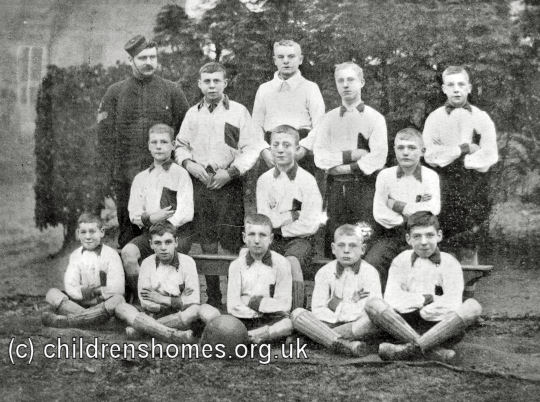
Leeds Boys' Reformatory football team, c.1900. © Peter Higginbotham
Sometime between 1908 and 1921, a pair of houses was erected at the east of the chapel, near the site entrance. These were used as residences for the deputy superintendent and the gardener (or 'Head of Horticulture').

Leeds Boys' Reformatory staff houses, 2008. © Peter Higginbotham
By 1917, the institution had become known as the Adel Training School for Boys. By that date, 2,460 boys had passed through its doors. During the previous three years, 151 boys had left the school of whom one hundred were in the army and five in the navy, while three had been killed in action, four had died of wounds, four of sickness and twenty-one had been wounded or gassed. Two old boys had gained the DCM (Distinguished Conduct Medal).
In 1933, the site became the East Moor Approved School for 135 boys.
The superintendent from 1937 to 1953 was Major Oldendorff who introduced new ideas and methods and gave the boys more freedom such as a two-week camp in Abergele in 1938. His approach was successful and he became much-liked and respected by the boys.
By 1958, the School's inmates were mostly aged from 15 to 18 and who were from "broken" homes or single-parent families. In 1962, around 120 boys were in residence, their length of stay ranging from six months to three years. They were occupied in cooking, painting, and building, some obtaining work experience with local firms.
In 1974, the School became a Community Home with Education (CHE) under the management of the Leeds Council Social Services department in 1974. It finally closed on 14 January 1991 and the remaining residents were transferred to Westwood Grange at Middleton. The premises were subsequently used to house Leeds Metropolitan University students until 2003 when the buildings were left empty.
The buildings was listed by English Heritage in 2009 as "extremely rare, with only 3 other listed examples and none of the size and completeness of Adel". Regrettably, there appear to be no plans to preserve the building which is understood to be under the ownership of Leeds City Council. This historic building is being left to quietly disintegrate.
Staff
- Superintendents:
- 1857-66: Joshua Haresceugh
- 1866-98: Charles Godfrey Twigg (his son James also served as a teacher at the school.
- 1898-1914: Charles James Walker
- 1914-37: Mr SL Whitmore
- 1937-53 Major Oldendorff
- 1953-74 Mr Eccles
- 1881 Census
Inmates
Records
- West Yorkshire Archive Service (Leeds Office), Nepshaw Lane South, Morley, Leeds LS27 7JQ. Holdings for "Leeds East Moor Community Home School": Admissions (1864-1981); Discharges (1874-1885 [combined with admissions' book], 1892-1978); Punishment registers (1907-73); Minute books (1859-1973); Medical Officer's reports (1918-74); Headmaster's reports (1930-55); Deeds 1857-1938; Records of Whinmoor Remand Home (1933-85); Records of Ainsty Lodge Home (1976-84); Salaries and conditions of service (1935-36); Air raid precautions (1939-41); Staff register; 1893-1953); Visitors' books (1858-1970); Annual returns (1938-50); Wages book (1956-63); Plans (1870-1976); Admission register (1960-1990).
-
Ancestry UK
has Admission registers (1864-1913) and Discharges (1874-1913).
Bibliography
- Carpenter, Mary Reformatory Schools, for the Children of the Perishing and Dangerous Classes, and for Juvenile Offenders (1851, General Books; various reprints available)
- Carlebach, Julius Caring for Children in Trouble (1970, Routledge & Kegan Paul)
- Higginbotham, Peter Children's Homes: A History of Institutional Care for Britain's Young (2017, Pen & Sword)
- Abel Smith, Doroth Crouchfield: A History of the Herts Training School 1857-1982 (2008, Able Publishing)
- Garnett, Emmeline Juvenile offenders in Victorian Lancashire: W J Garnnett and the Bleasdale Reformatory (2008, Regional Heritage Centre, Lancaster University)
- Hicks, J.D. The Yorkshire Catholic Reformatory, Market Weighton (1996, East Yorkshire Local History Society)
- Slocombe, Ivor Wiltshire Reformatory for Boys, Warminster, 1856-1924 (2005, Hobnob Press)
- Duckworth, J.S. The Hardwicke Reformatory School, Gloucestershire (in Transactions of the Bristol and Gloucestershire Archaeological Society, 1995, Vol. 113, 151-165)
- Higginbotham, Peter Children's Homes: A History of Institutional Care for Britain's Young (2017, Pen & Sword)
- Hyland,Jim Yesterday's Answers: Yesterday's Answers: Development and Decline of Schools for Young Offenders (1993, Whiting and Birch)
- Millham, S, Bullock, R, and Cherrett, P After Grace — Teeth: a comparative study of the residential experience of boys in Approved Schools (1975, Chaucer Publishing)
- Cole, Don Going to School in a Yorkshire Parish (1985).
Links
Acknowledgement
- Thanks to Ann Lightman (Adel History Group) for her contribution to this page.
Except where indicated, this page () © Peter Higginbotham. Contents may not be reproduced without permission.


